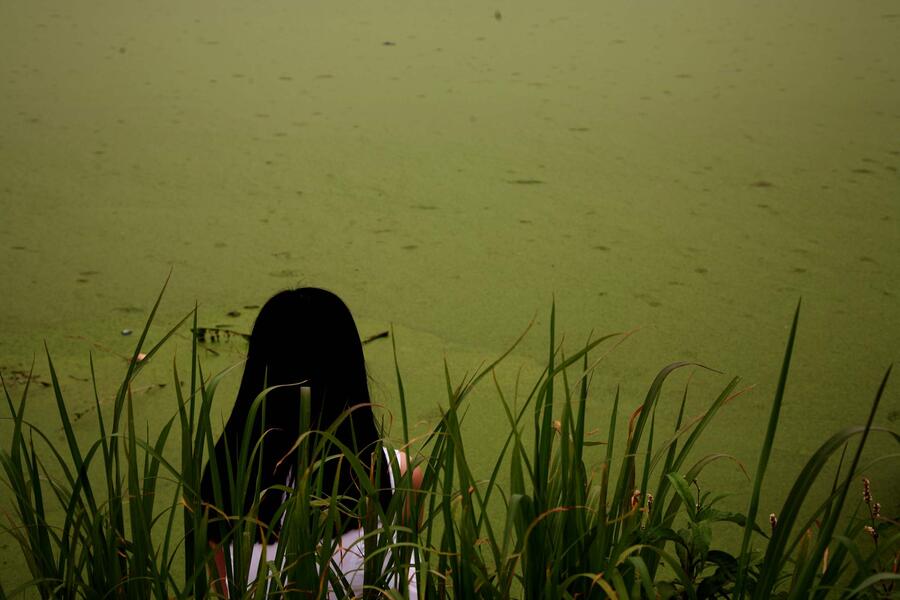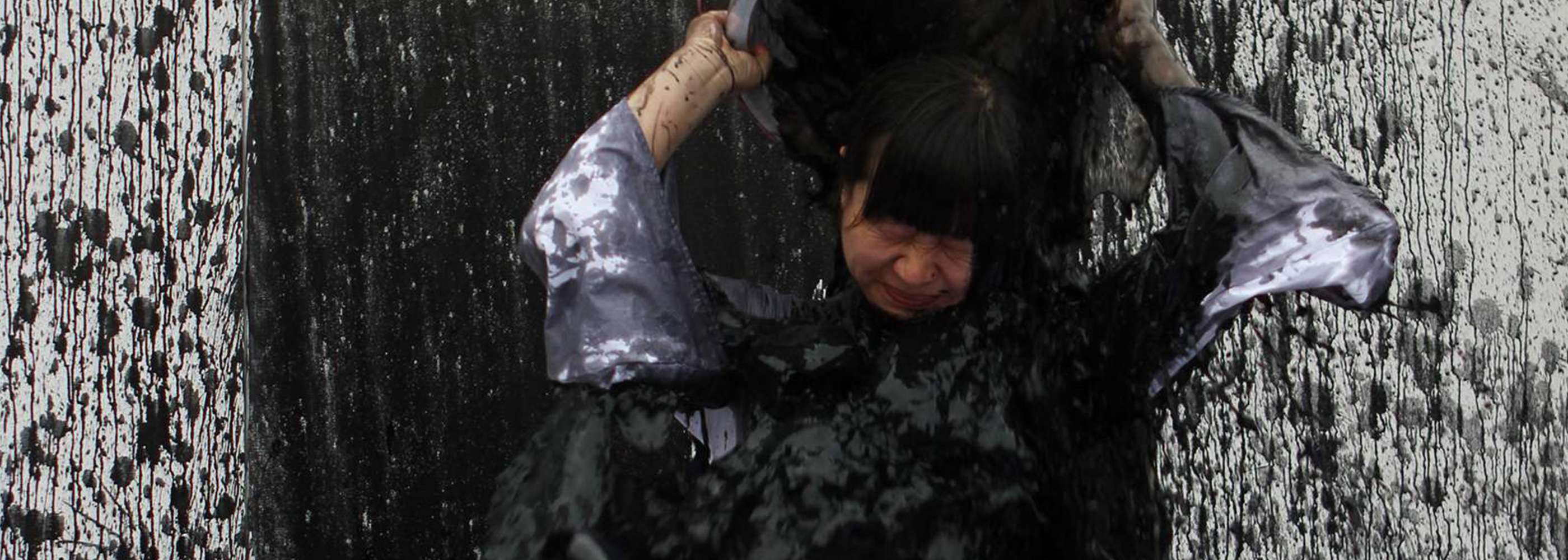

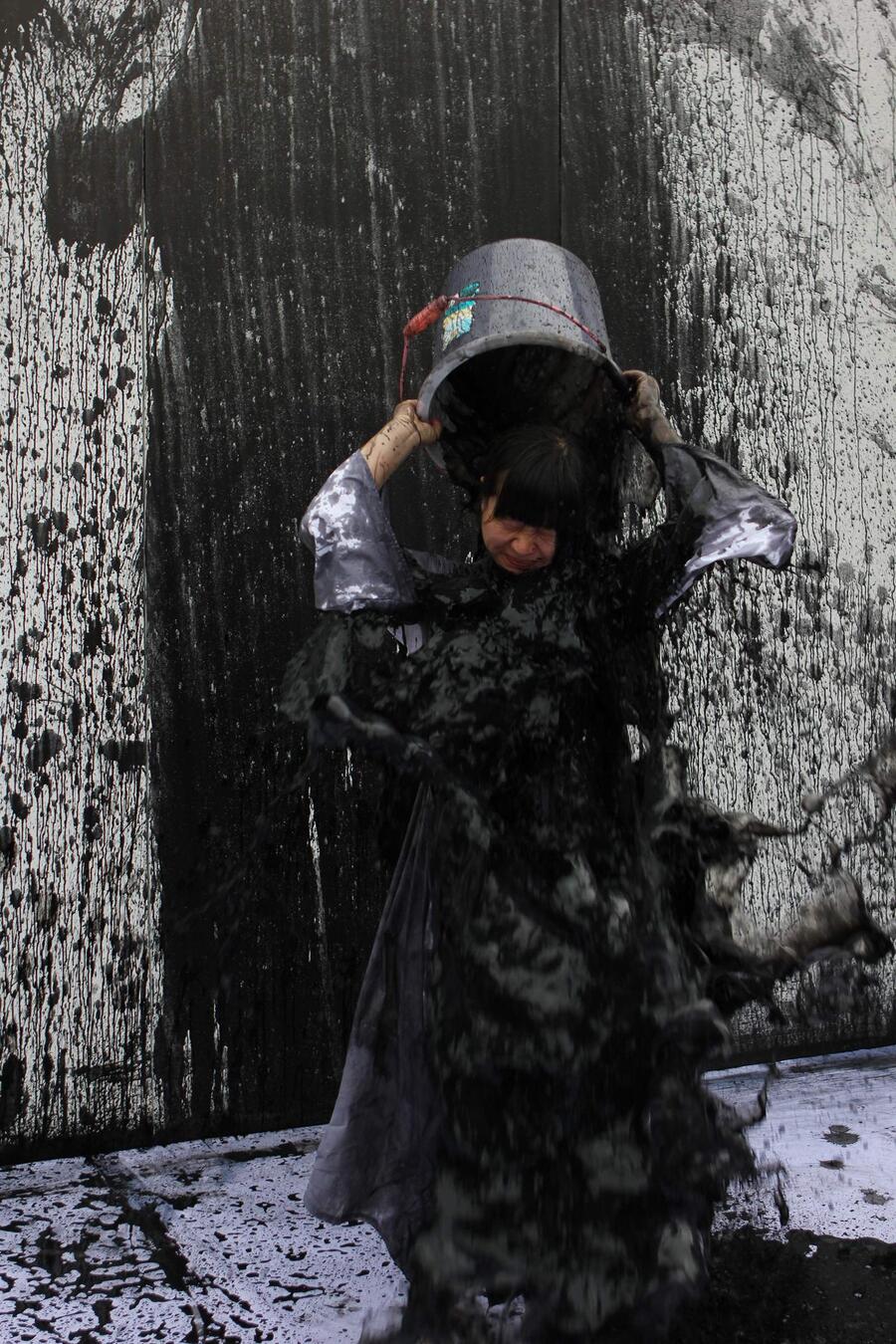
Luise Guest: I understand you studied Chinese painting at Tianjin Academy of Fine Arts - why did you begin to work as a performance artist rather than continue working only in painting? What is it about the nature of performance art that especially interests you?
Li Xinmo: I studied painting since I was a child and have always loved Chinese ink painting and calligraphy. Majoring in design at university, I really wanted to study Chinese painting, so after the graduation, I went to Tianjin Academy of Fine Arts to study Chinese painting. At that time, I was immersed in the study and research of classical landscape painting every day. Later, I was admitted to the Chinese Painting Department of Tianjin Academy of Fine Arts as a graduate student, specializing in ink painting. I remembered going out to sketch once in an early summer. I was walking on the road and saw a black river and trees on both sides of shores were all withered. I was so shocked by what I saw. When I stood in front of real mountains and rivers, I realized that the peaceful and beautiful world in ancient landscape paintings no longer existed. China's rapid modernization process and excessive consumption and abuse of nature have destroyed the natural ecosystem. All the sudden, a huge question arose in my mind: "Why do I paint?", "How do I face reality?"
I realised that the brush and ink can no longer deliver my feelings for the cruel real world. It was at this time that I had the opportunity to work as a tutor with a professor teaching contemporary art at the School of Modern Art. I became interested in contemporary art. The diversified concepts of contemporary art and creative methods immediately attracted me. Particularly, I was deeply influenced by Beuys's artistic concept, so I started to read contemporary art theory and make contemporary art.My practices have been paying close attention to social issues from the very beginning, such as issues of human rights issues and environment in which water pollution was my focus. It may be because of my study of landscape painting. I switched my focus from traditional landscapes to the real. When researching contemporary art, I also read about feminist theory and feminist art, and those strong feminist expressions immediately attracted me. When I review my past and observe myself from a feminist perspective, I find that I can express my experiences through feminist art. Combining ecologism with feminism, and China's water pollution with the situation faced by Chinese women, I expressed the position and concept of ecological feminism. Therefore, I made my first performance work "Death of Xinkai River", and then the curator of Da Dao Live Art Fair/Festival saw my work on the internet and invited me to participate in Da Dao Live Art Fair/Festival. Later, I made another work "A Farewell Ceremony" related to issues around the environment and women.
The liveness of performance art attracts me in the first place. Performance art is made on site, and different spaces give me different feelings. The presence of the audience is also very important, who will stimulate my energy. During the performance, I can deeply feel the energy exchange and empathy between me and audiences. I hope my performances can impress my audiences, and they do. Every time my performance deeply shocks and moves audiences, and many of them are in tears. This is also what attracts me to performance art – a space that I struck a chord with my audiences.
Through performance art, I can express my emotions in a very strong way. Those innermost traumas and repressed emotions can be expressed and released in the process of making performance art. Therefore, performance art has a healing effect on me. After every performance, I felt released. Every performance is like a ceremony, a ceremony to bid farewell to one's past.
Some parts of performance art are uncontrollable and unpredictable, since it is not rehearsed like a drama, but performed once. Unexpected and uncertain things will happen. However, I have found that it is these uncertainties that make the work appear beyond expectation and these uncertain factors make the scene of performance more challenging and attractive.
Luise Guest: How did you come to be involved with the Bald Girls in their first exhibition in Beijing? And when did you begin to think of yourself as a feminist artist?
Li Xinmo:I have been making a series of feminist works since 2008. Once these works were released, they caused huge controversy. The visual elements and subjects of these works were taboo, such as menstrual blood, sexual violence, etc., and I have published a series of feminist articles and critiques on the Internet. As a result, I was ostracized and demonized by art circles in China.
In November 2011, I met Xu Juan, a German-Chinese curator introduced by artists Gao Brothers. She said that she was planning to curate an exhibition about feminism in China, and she hoped that both Xiao Lu and I could participate. I contacted Xiao Lu and asked her if she would like to be in this exhibition, and Xiao Lu gladly agreed. A Chinese female artist Lan Jing living in Germany also participated in the exhibition. In the following discussion, we came up with the title of the exhibition " Bald Girls [pinyin: Tu Tou Ge Nv]". In fact, "Bald Girls" is also the name of this artist group which is composed of the curator and three artists. The exhibition was held at the Iberia Contemporary Art Space in Beijing 798. At the opening ceremony, Xiao Lu suggested the three of us shaving head together. This exhibition is different from other women's art exhibitions in China. It is a clear-cut feminist art exhibition, which has significant meaning in China.
After been part of "Bald Girls", I became more clear about my identity as a feminist artist. I also found that Chinese female artists basically refuse to admit that they are feminist artists, and they basically deny that their artworks are feminist artworks. The reason behind this is that China is a very patriarchal society, as is the art world. Men dominated the voices to speak, such as critics and curators, and women who want to participate in exhibitions need the support from critics and curators. Talking about feminism is disapproved, which made women artists terrify of being sidelined. In such a situation, I think it is necessary for me to admit regardless that I am a feminist artist. It is precisely because everyone is afraid, shunned, and afraid of feminism that I think it is more meaningful and valuable to advocate feminism in China.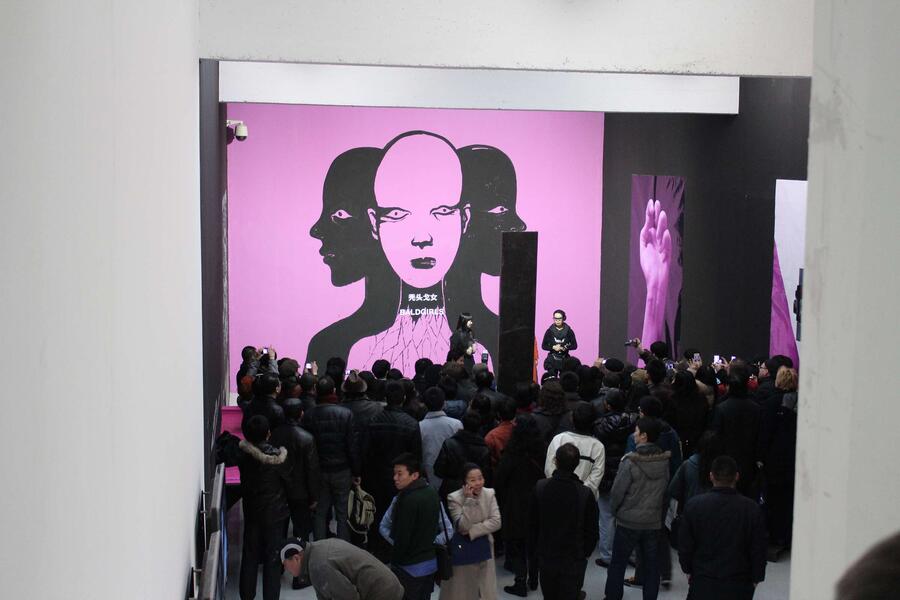
Luise Guest: I'm very interested in the works "Tea Ceremony" and "Rinsing" - where exactly were these works performed? What is the significance of using ink, for you? The works were performed during a feminist exhibition, could you explain a little more about your intended meaning/s with these 2 linked performances?
Li Xinmo: The two works were performed in the Jiangsu Hai’An Art District. In 2013, I curated a feminist exhibition there, called "[Alien Body][pinyin: Yi Zai de Shen Ti]". The exhibition opened with performances by several female artists. I did two performance works "Tea Ceremony" followed by " Rinsing". Ink is the material I use when painting Chinese paintings and writing calligraphy. Ink is a symbol of the traditional Chinese culture, but it also symbolise pollution. When drop ink into water, it will dye the water black.
In “Tea Ceremony”, I filled a clean teapot with a mixture of ink and water, then filled eight teacups, and I drank the black tea one by one. Drinking tea is the daily behavior of Chinese people, but I replaced tea with ink to express my rebellion and thinking about traditional ideas and a fixed routine of life. Every one of us is shaped by society and culture, and a large part of our way of thinking and habits follow an old cultural tradition, such as the idea of men being superior to women, such as the concept of hierarchy.
These concepts affect everyone so deeply and no one thinks they are incorrect. People get used to them as much as they get used to their daily life. I just made something different to our normal behavior by performance art. The ink tea is not drinkable and even harmful to human body, but I behaved ritually to drink this undrinkable ink. The performance alienated from our daily life, which create "thorns" or conflicts in a work, which make the audience rethink: Is there a problem with the conventional concept in we our daily life?
"Rinsing" is an independent work after "Tea Ceremony". In "Rinsing", I use water mixed with ink to wash my clothes and body. Although the title was "Rinsing", but I wash with black water. Rinsing originally meant washing away dirt with clean water, but in this work I was washing clean clothes and body with dirty water. It is a metaphor of the experience that women were often stigmatized in society and our cultural tradition.
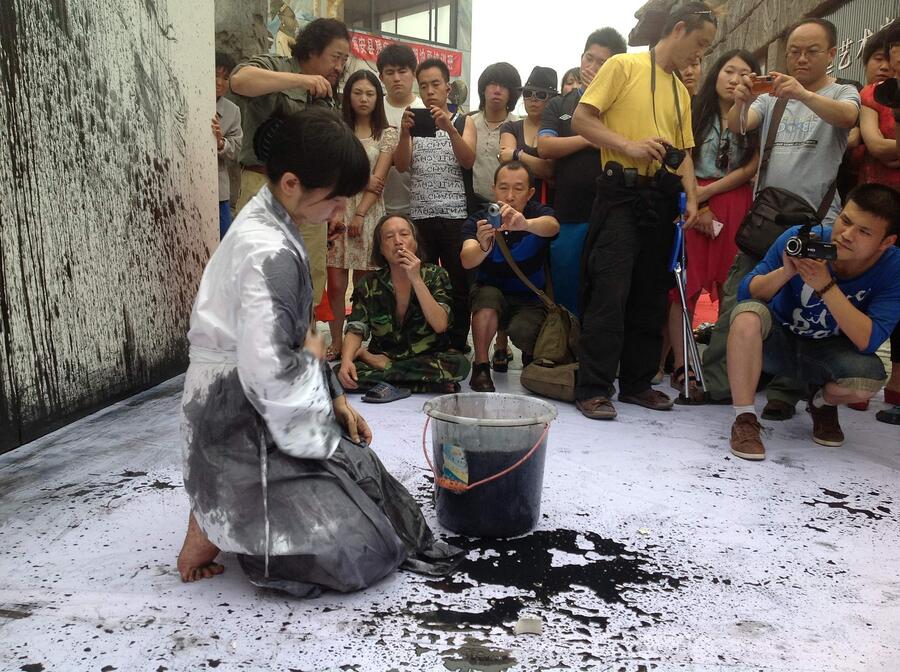
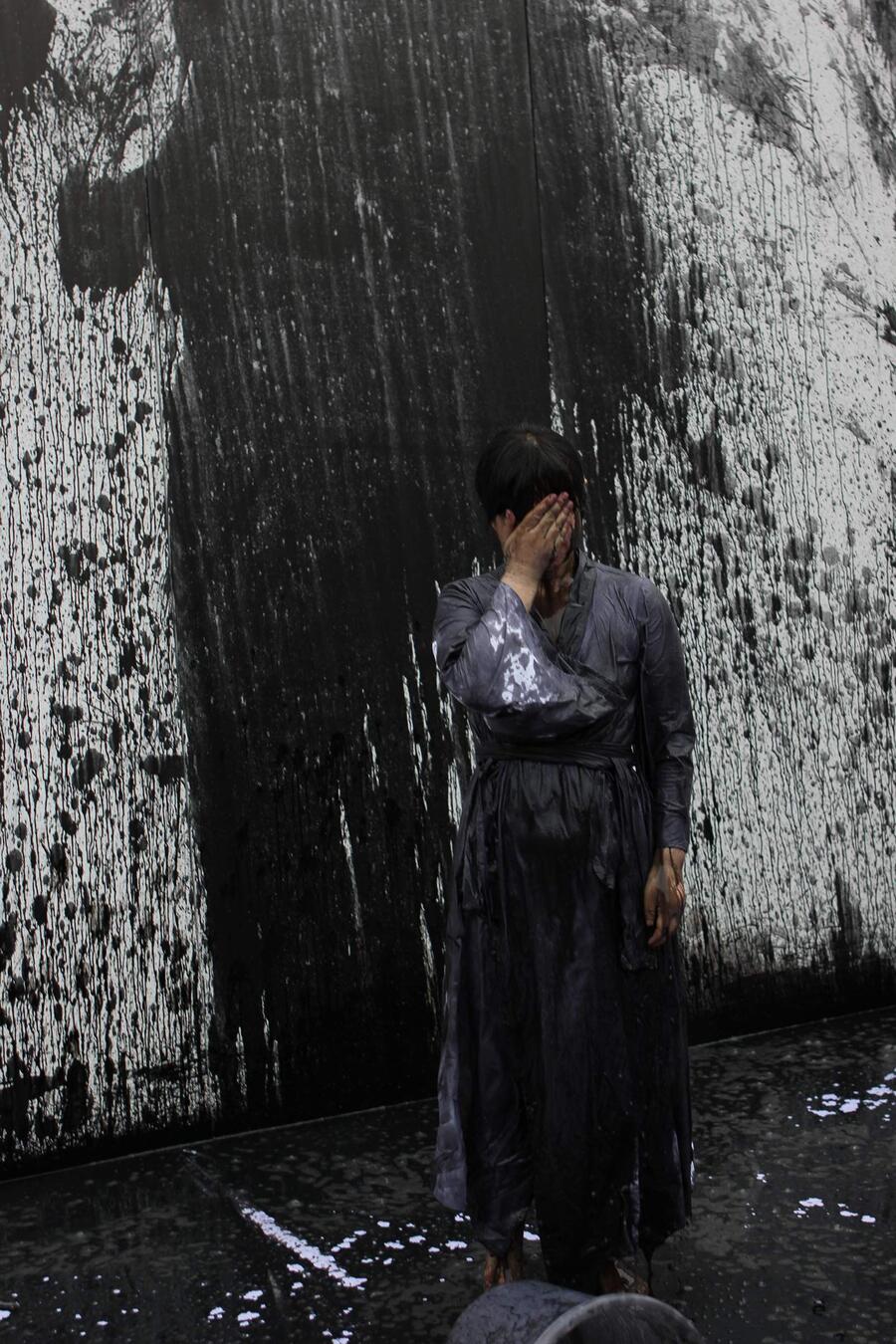
Luise Guest: Could you explain your feminist intention with the work "Scripture Writing" in 2018? Why did you feel it was important for a woman to copy out the sutras?
Li Xinmo: When I was studying Chinese painting at Tianjin Academy of Fine Arts, I had a male classmate who read a lot and was very knowledgeable. He also knew a lot about Buddhism. At that time, I was also very interested in Buddhism. Every day I copied scriptures into calligraphy. One day he said to me, "Don't take it too seriously, a woman cannot attain Buddhahood." His words gave me a huge blow and made me doubt myself. When I looked back on the stories of the Buddhist scriptures, it is true that I cannot find an image of a female Buddha. Shakyamuni Buddha, Maitreya Buddha, Samantabhadra Bodhisattva, Manjushri Bodhisattva - Buddhas and Bodhisattvas that I admired are all male bodies. And I read a lot of Dunhuang writing scriptures, and the people who copied these scriptures were called ‘scripture monks’, not ‘scripture nuns’. That is, the people who copied the scriptures were also men, not women. At the time, I knew nothing about feminism, the concept of patriarchy, nor that the entire cultural history was written by men. It stuck me so much as I was devoted to attaining Buddhahood at that time. It was only after I read feminist theories that I realized that the suppression of women is a structural suppression. Women have been excluded from social public discourses and producing culture. In ancient times, they did not have the right to be educated or learn how to write.
In 2018, the "Story of Paper" , a large-scale art exhibition held by the Far East Museum in Sweden, exhibited Asian works on paper which were mainly from Japan and China in the collection. It exhibited works of writing scriptures alongside with contemporary artworks on paper including one of mine. The curator invited me to make a performance installation related to paper and writing. Therefore, I created this "Writing Scripture – Women[pinyin: Xie Jing - Nv]". I copied the verses of the Lotus Sutra in regular script in small characters on a 30 meters long silk paper. The Lotus Sutra was an antique copy in the collection and my performance communicated with the scriptures. I copied most of the scriptures in advance and brought the half-written scrolls of scriptures from China to Sweden. In the exhibition space – the scroll was hung from the second floor extended to the ground level, folded on a shelf, and then extended to a table, where I continued to write the rest of scriptures.
This work is about the male-dominated Buddhism, and it is also an act of writing by women, as well as the history of calligraphy. In the history of Chinese calligraphy, there are almost always the names of male calligraphers, and almost no female calligraphers. Women have almost lost their voices entirely in China's 2000-year cultural history. This is also the cultural reality we face today. Male-dominated arts and culture have continued to this day. As women today, we can be educated, we can pick up a pen and write, but we are still in this patriarchal cultural system. For example, I can now pick up a writing brush and call myself a calligrapher, and I can write Buddhist scriptures in public spaces as a woman, but the contents of the scriptures I copy are still written by men. To this day, women who participate in producing culture are still in the minority.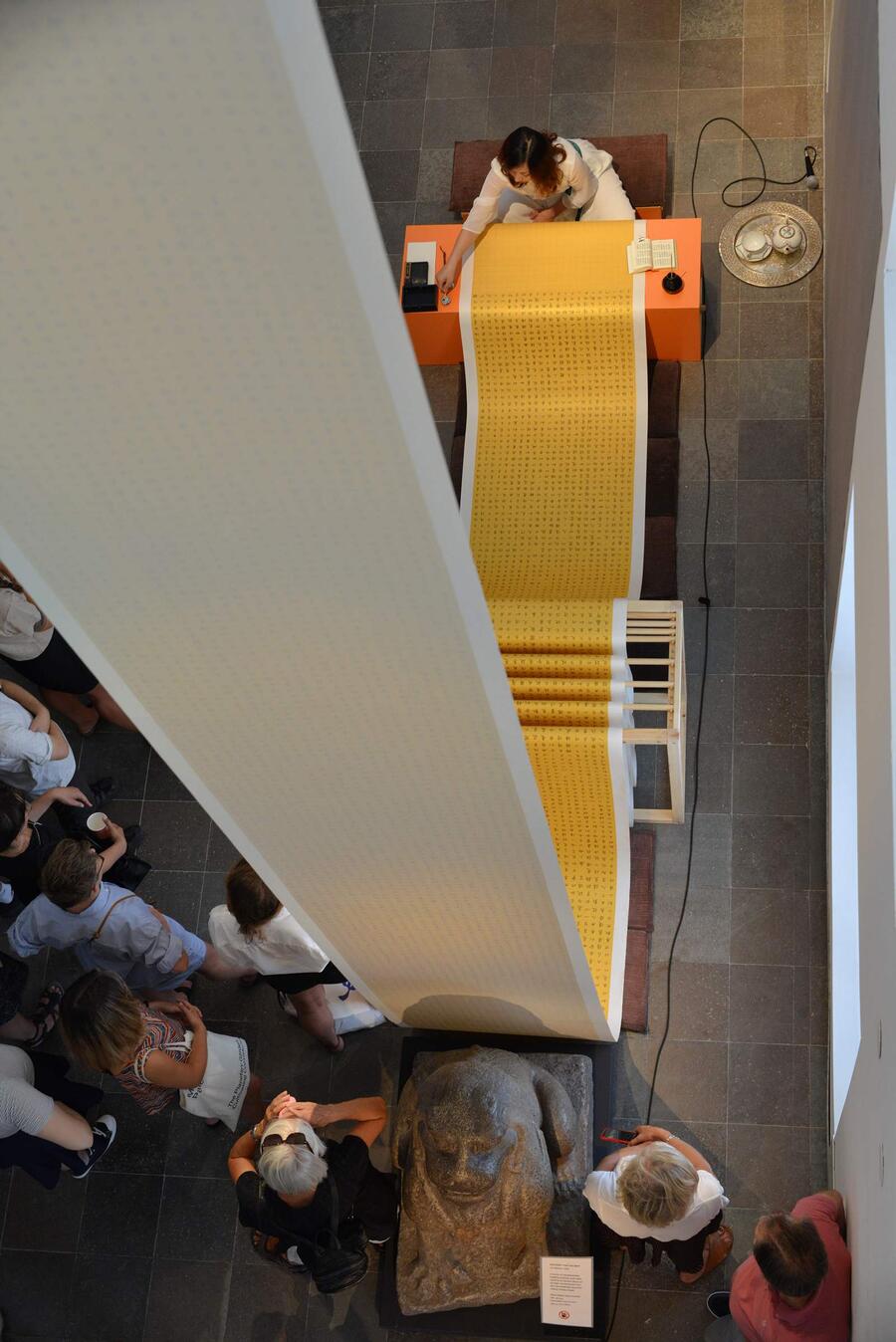
Luise Guest: Do you think there are aspects of your work that are specifically Chinese, or is performance art a global artform?
Li Xinmo: Performance art is a popular artistic expression on the stage of international contemporary art, and I often participated in international performance art fairs and prefer this way of expression. I don't think much about Chinese identity, Chinese characteristics, and Chinese symbols, but focus more on individual memories, traumas, and experiences, including the experience of reading. Some of my works are from my own experience, some from poetry and fables, and some from my concern for natural ecology and social reality. The themes are diverse. When I review my works, I also see some common features, one is the care for nature, and the other is the frequent use of the element of water. This may be related to traditional Chinese Taoism. In some of my works, I also focus on element of writing with a brush, which may be more Chinese, and also something special in my performance.
Luise Guest: Which artists have most influenced your own practice?
Li Xinmo: Firstly, Marina Abramović's performance art greatly influenced me. It struck me deeply when the first time I saw her performance work, Lips of Thomas - the bleeding Star of David cut into her belly, in Huakan magazine. Later, I saw her other performance works, and was so fond of every piece. Carolee Schneemann's daring experiments with the body, especially her Interior Scroll, also showed me the power of feminist art. I was greatly touched and inspired by her works. There is also Yoko Ono's Cut Piece which is still fresh in my memory. Many female artists have deeply influenced me.
Luise Guest: “A Farewell Ceremony” - Performance at Dadao International Live Art Festival Rain Gallery - why this title? Does it reference the Death of the Xinkai River, or environmental issues more broadly? Who or what is being farewelled?
Li Xinmo:“A Farewell Ceremony" is another performance work I did after "The Death of Xinkai River". "Death of Xinkai River" is a tribute to the polluted Xinkai River and a memorial to a girl who was raped, killed and thrown into the river. I made "A Farewell Ceremony" in the gallery space. I customized a glass tank and collected water and blue-green algae from a polluted river between Beijing and Tianjin. I lay in the glass tank, and the foul-smelling water mixed with rotting blue-green algae slowly poured into the tank until I was submerged.
When I was doing this work, I thought about the dying fish in the polluted water, and the woman who was unable to resist in a desperate situation. That was also my situation at that time - a single mother, under the pressure of public opinion and the ridicule from everyone, I was on the brink of collapse. This performance work is autobiographical, "A Farewell Ritual", which is a ritual of my death. In the cold and stench water, I tried to say goodbye to the world and my wounded self.